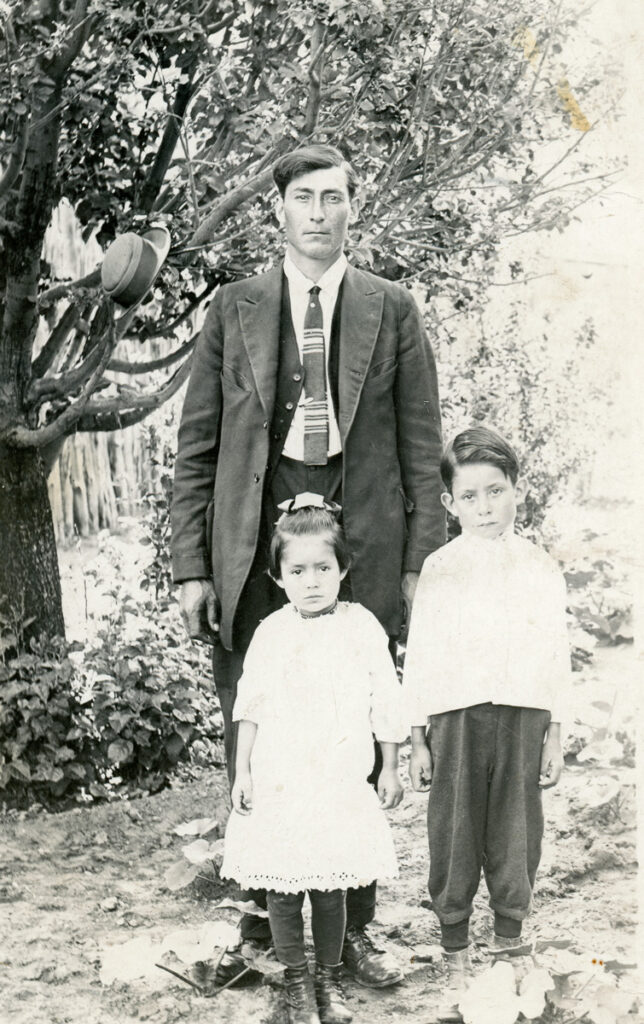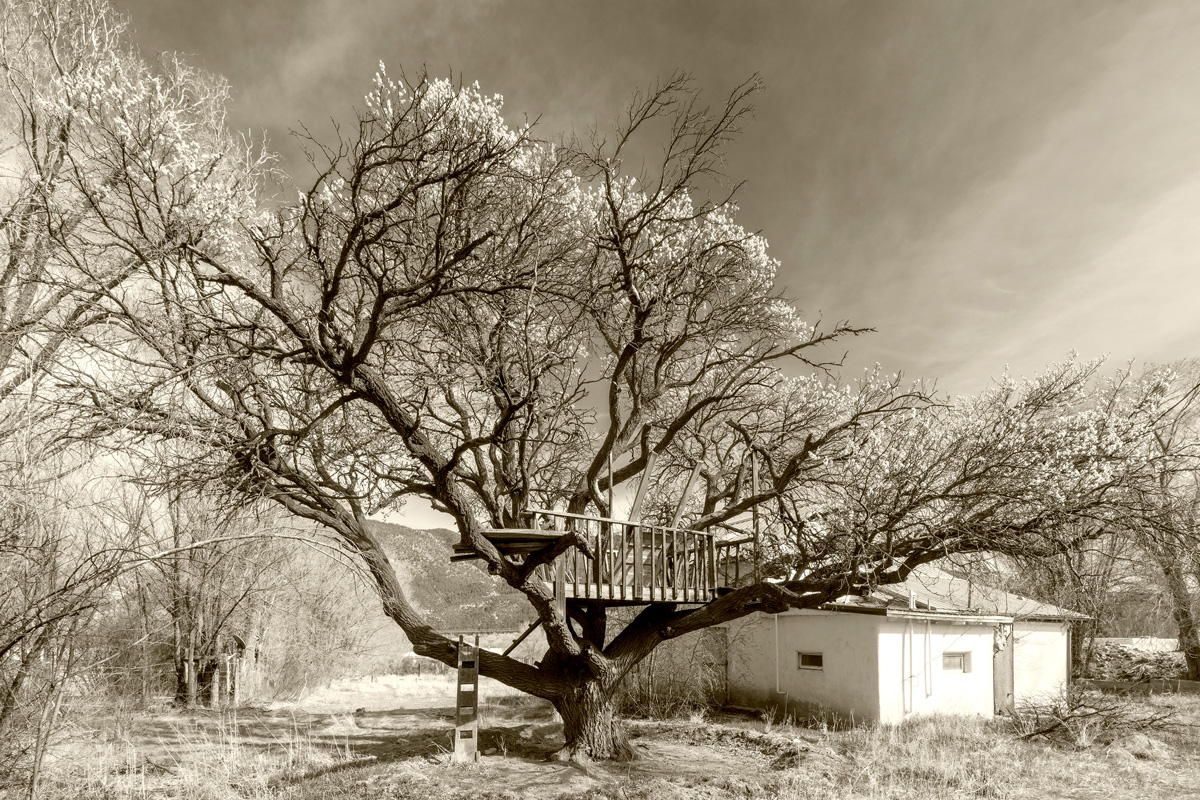By Dr. Esevan Rael-Galvez
The village of Questa, formerly named and remembered still as San Antonio del Rio Colorado, is set in an ancient and sovereign geography. This is the place where I spent my most formative years, in a home surrounded by an orchard of several varieties of plums, pears, apples, and chokecherries. At the center of this grove stood, and stands still, the most majestic tree of all— Abuelo Albarcoque, Grandfather Apricot. To this day, that tree reminds me of the most precious things passed down to me from my grandmother.
Grandparents, even those that are trees, have deeply embedded histories, and the Abuelo Albarcoque that raised me is no exception. This legacy reflects a complex narrative of origins, language, and migration and ultimately, perhaps, wisdom itself.

Language and Origins
The words “apricot” and “precocious” share the same root and essentially the same meaning, since the early definition of precocious, praecocia, literally means “early ripen.” Gaius Plinius, an early Roman naturalist, first referred to this “early variety” of peach (persica), which “ripens early in the summer, the precocious one.”
The ancient Greeks referred to the apricot as berikokkia, which Arabic speakers evolved to al-barqūq, revealing the linguistic journey of the word that we know today in English. In Argentina, Chile, and Peru, the word for “apricot” is damasco, which could indicate that, to the Spanish settlers of Argentina, the fruit was associated with Damascus in Syria.
From its early roots to 16th century Spain, the common term would have been albaricoque. Today, in New Mexico, an apricot is referred to differently depending on the area. In the northern part of the state, the fruit is called albarcoque, while in central regions it is common to hear a slight difference in the word (albercoque), each word reflecting the breadth and depth of Arabic influence on the Spanish language. In the south and throughout Mexico, the term chabacán or chabacano is more common. The origin of this term is more difficult to trace since it is more widely used as a language of the Philippines, and as an adjective, means ‘awkward,’ ‘crude,’ or ‘tasteless.’ The linguistic scholar, Corominas, suggests “that it is after all, a sort of insipid peach.”
Beyond the etymology, the origins of the apricot are layered and complex. It may have emerged first in Armenia, where seeds were found in the Temple of Garni and the Shengavit Settlement from the Bronze Age. Its cultivation in India in 3,000 BC or in China suggests earlier origins. Taken along the Silk Road from these places to the Middle East and from there to Spain in the 1100s, they would eventually be transported to the Americas. Throughout Mexico and up the Camino Real into Santa Fe and from there, as each family moved north in search of arable lands, those kernels went with them to Santa Cruz, Chimayo, Trampas, Penasco, Abiquiú, and up to Taos, into Arroyo Hondo, and finally into Questa and further north—each seed, each tree, carrying the genetic memory of what preceded it.
History in New Mexico
Apricots were joined by a medley of fruits on their journey. In the Americas the Mediterranean trilogy of wheat, grapes, and olives met corn, squash, and beans, the Native-Indigneous trilogy. Colonizers of the Americas encountered fruits and vegetables that were unfamiliar to them, the most notable being chile.
Euro-Mestizo settlers had only been in New Mexico a short period when Fray Alonso Benavides visited New Mexico in 1625 and again in 1629. Upon his return to Mexico City, he wrote a report describing land and people, including a paragraph describing the “Fertility of the Soil.”
All this land is extremely fertile, yielding with very great abundance all that is planted on it—corn, wheat, beans, lentils, garbanzos, chick-peas, lima beans, vetches, squash, watermelon, cantaloupes, cucumbers, all sorts of garden-stuff, cabbages, lettuce, carrots, artichokes, garlic, onions, prickly pears, cacti, very good plums, apricots, peaches, nuts, acorns, mulberries, and many others.
While it can be challenging to find something as obscure as apricot references in colonial period records, it is clear that the trees were there. A reference in the Bernardo Lopez de Mendizbal and Teresa Aquilera y Roche 1664 Inquisition testimony reveals an orchard east of the Palace (Casas Reales). Just a few years later, during the Pueblo Revolt of 1680, a watershed moment in New Mexico history that represented one of the first and greatest revolutions of the continent, legend has it that people were advised to eradicate all vestiges of the Spanish presence, including fruit trees.
Among the many things brought by the Spanish, by this time these trees had become integral to Pueblo life. It is difficult to say whether all orchards were destroyed. Some scholars speculate that in a drought, destroying food would have been antithetical, even if symbolic; if some trees had been destroyed, seeds may have been hidden away, and in time replanted. Excavations at the Palace of the Governors have revealed layers of peach and apricot pits, dating as far back as this early period.
Following reoccupation, the nearly two centuries of European-Mestizo settlement in New Mexico revealed that these orchards continued to expand. One of the most vivid descriptions came in 1776, when Fray Atanacio Dominguez was ordered to inspect the two dozen missions and report on their condition. His report covered the major villages and Pueblos, and provides a fascinating snapshot of the area at a pivotal moment in American history. Of the still small population of Albuquerque (763), Dominguez observed, “There are also little orchards with vine stocks and small apricot, peach, apple, and pear trees,” and of Santa Fe, he wrote: The Villa of Santa Fe [population of 1,167) consists of many small ranchos at various distances from one another… the harvest consists of wheat, maize, legumes, and green vegetables, and also fruits such as melons, watermelon, and apricots, of which there are small orchards. In his visits to northern Puebloan communities, among the many fruit trees found, Dominguez reported the existence of apricots.
Some of my favorite documents are last wills and testaments, more than the actual decrees and civil records. They carry the stories of how people are connected, their spirituality, and about where value is placed in the material culture.
At the end of their lives, as the people of colonial era New Mexico took stock of their experiences and decided what to pass on, these objects reveal a great deal about what held value. Among the saints, rooms of a house, animals, and land endowed to others can be found fruit trees, sometimes left as entire orchards, other times divided, or even simply bequeathed as a single tree. Bernardino Sena, mentioned in his will of 1765 an orchard in the original Sena house on the Barrio de Analco east of San Miguel Chapel.
Just as is true of the Spanish and Mexican periods of New Mexico history, travel writers commented on New Mexico post-U.S. occupation. Trader, J. Webb observed in the 1850s that “Don Augustin Duran, Don Felix Garcia, Don Antonio Sena y Baca, and James Conklin and others lived not far from where the Presbyterian church now stands and had grand houses for the time; and some two or three acres cultivated in corn, beans, and red peppers, and a few apricot trees, the only fruit then raised in the town.” By 1865, when Kentucky native James Giddings was providing testimony and commenting on the landscape near Fort Sumner, he wrote that among the peaches and grapes, that “apricots do very finely here.”
It also is important to note that when Kit Carson rounded the Diné (Navajo) from Canyon de Chelly in 1864, he ordered his men to destroy most of the orchards, but a few fruit trees were tucked away in remote side-canyons and managed to elude the soldiers. To this day, while doing research in Dinetah, the Navajo homeland, I saw that farmers still raise peaches and apricots, reminding me of resilience.
There are few native Nuevomexicanos commenting on apricots specifically in historic records. One of the most well known was that of Fabiola Cabeza de Baca, an author and nutritionist who made tremendous advancements in food safety in the southwest, teaching many 20th-century village women how to properly can, dry, and preserve food. In some of her early writings, she described orchards of family members, including that of apricots.
Conclusion
There is another Arabic word for the fruit—mishmish. This term refers to the notion that if someone is making plans or a promise that you know will not be completed, or if they are speaking of lofty dreams, Egyptian and Palestinian Arabic speakers might roll their eyes and say “bukra fil mishmish,” translating to “tomorrow, when apricots are in season.” Mishmish refers to the fact that some apricots are only really delicious on the day that they’re harvested. As I think about the narrative and journeyed history, meaning and essence of the apricot, metaphorically, it is really about seizing the day, the moment, what is most precious right now, savoring it. This is perhaps the gift of wisdom most carried by the apricot—to not let what is before us pass us by.
The other lesson from the apricot’s story is the importance of heritage to our sense of identity and place. Although the fruit now has a global and intricately layered legacy, it is important to acknowledge the stories held by our ancestors. The grandfather Abuelo Albarcoque in Questa embodies this for me. I was fortunate to have a grandmother whose wisdom always encouraged me to draw deeper still from the wells of memory, and to take those stories, center them, and raise them up. I remember her making a swing for me, secured by this tree’s limbs. I remember the harvest of the fruit, which she led, and its transformation into jelly.
I never knew my grandfather, the one who may have planted this tree, though I recently discovered an image of him beside that tree. In that image both my grandfather and the tree are young. His hat hanging in the branches seems like a poetic message about his connection to it and my deciphering it in the way I have. While I never knew Papa-Abuelo, I did have the honor of being the grandchild of this magnificent tree, from whom I learned about the importance of deep roots, of standing tall, about resilience, and above all, about nurturing family and community.
Copyright 2018 Estevan Rael-Gálvez



